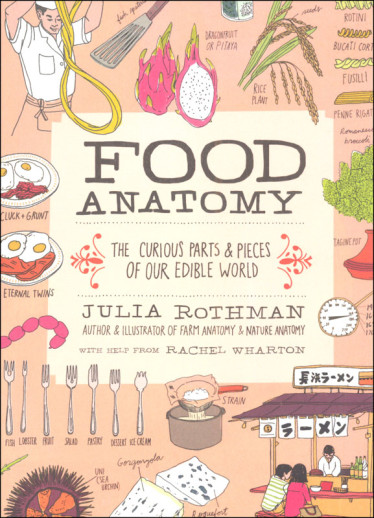We use cookies to make your experience better. To comply with the new e-Privacy directive, we need to ask for your consent to set the cookies. Learn more.
Food Anatomy: Curious Parts & Pieces of Our Edible World
Tour a world of cuisine and traditions that have formed over many years. You will learn what makes a fruit a fruit, how different nuts grow, and how grains are plant seeds. The illustrations and text have a charming quality. You can open to any page and learn something valuable. This would be a good addition to a cooking lesson or home economics-type course. I like how you see similar items grouped together so you can see what is different about them. There is a huge variety of topics covered! ~Sara
Get your recommended daily allowance of facts and fun with Food Anatomy, the third book in Julia Rothman's best-selling Anatomy series. She starts with an illustrated history of food and ends with a global tour of street eats. Along the way, Rothman serves up a hilarious primer on short-order egg lingo and a mouthwatering menu of how people around the planet serve fried potatoes — and what we dip them in. Award-winning food journalist Rachel Wharton lends her expertise to this light-hearted exploration of everything food that bursts with little-known facts and delightful drawings. Everyday diners and seasoned foodies alike are sure to eat it up.
Young readers will satisfy their curiosity as they learn about the details of the ocean or the natural world in these easy-to-read books. Some of the topics in the Nature Anatomy include minerals, weather, and animals. Ocean Anatomy includes interesting information about the ocean, the anatomy and details of a fish, and coral reefs. There are so many detailed illustrations and fascinating facts in these books and the page layout is kid friendly.
The neat sticker books feature the illustrations found in Julia Rothman's Nature Anatomy books. If you're already a fan of this informational series, you'll love having these stickers to place on calendars, planners, scrapbooks, stationary, and more! The colorful stickers have a papery texture. Each sticker book includes at least 750 stickers.
Consumable activity books extend the learning from the charming Julia Rothman Anatomy books. You may find crossword puzzle, drawing assignments, mazes, craft projects, visual discrimination activities like matching or finding hidden images, graphing data, pop quizzes, word scrambles and lots more! The pages have the same charming illustrations found in the Anatomy books.
The educational puzzles each feature a picture illustration from Julia Rothman's Anatomy books. Each puzzle has a theme, and pictures of an assortment of animals and plant life, many of them labeled with the species type or anatomy diagram. The puzzles measure 23.75" x 19" when completed, and include an 8 ⅜" x 6 ⅝" demonstration poster.
| Product Format: | Paperback |
|---|---|
| Brand: | Storey Books |
| Author: | Julia Rothman |
| Grades: | K-5 |
| ISBN: | 9781612123394 |
| Length in Inches: | 9 |
| Width in Inches: | 6.5 |
| Height in Inches: | 0.8125 |
| Weight in Pounds: | 1.35 |

